Members of the antelope family, the graceful gazelle inhabits the grasslands, savannahs, and deserts of central Asia, Africa, and India. Almost every species of gazelle is threatened or endangered.
The majority of gazelle species have light tan or fawn hues. They stand two to three and a half feet tall at the level of their shoulders. Animals like gazelles are delicate, slender animals that are typically connected to feminine beauty.
As prey animals, gazelles are preferred by lions, leopards, cheetahs, and crocodiles as their diet.
Their capacity to sprint briefly at up to 60 miles per hour is frequently their sole chance of surviving. They are also capable of jumping and leaping to avoid capture.
Gazelles are migratory animals that feed through grass, leaves, and other vegetation. An essential component of their semi-arid environment, they have adapted to obtain the majority of their water from the plants they consume.
They don’t require water to digest their meal because of their correspondingly huge salivary glands.
While they may not always reside together, mother gazelles tend to their young and keep them safe from harm.
The mother gazelle visits her fawns around feeding time, but she spends the rest of the day grazing in the general vicinity. The fawns hide in tall grassy regions.
She won’t try to fend off a lion or cheetah, but she will protect her fawns from most predators.
The family that includes gazelles also includes antelope, goats, sheep, cattle, and deer.
Animals like gazelles and antelopes can be found throughout Africa, Europe, Asia, and North America, with a wide range of species calling Africa home.
Now let’s look at some of the animals like gazelles relatives who inhabit the same part of Africa.
1. Duiker
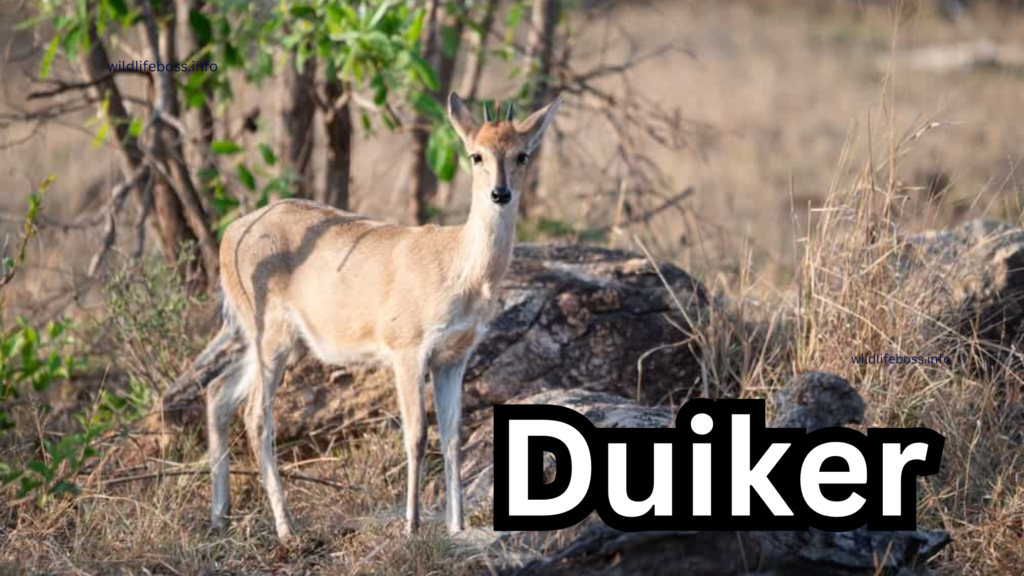
Scientific Name (family): Cephalophus.
Quick Summary: Something that dives for living resembling an antelope.
Medium-sized antelopes known as duikers are found in the forested areas of sub-Saharan Africa and are classified into 22 species. The shy and evasive duikers like to hide in densely forested regions so they can rapidly run for cover if they feel threatened.
Since the name “duiker” refers to the way an animal dives for cover when frightened, it was actually derived from the Afrikaans word for “to dive.”
Gazelles have long, lofty horns, whereas duikers have short, stubby horns. The majority of variants are physically suited to woodland environments rather than plains and have shorter legs than gazelles.
The duikers can maneuver through even the densest forest with ease thanks to their short, robust necks and compact bodies.
The duiker’s size was determined by its species, habitat, and food source. There is a clear correlation between an animal’s body size and the quantity of food in its habitat.
The females of some duiker species, such as the common duiker, are obviously bigger than the males.
The duiker and the gazelle are similar in that they are browsing animals that mostly consume fruits, grasses, leaves, and shoots. Unlike gazelles, duikers will consume meat as well, although usually in the form of carrion and insects.
Nonetheless, duikers have been seen catching and consuming small rodents and birds.
2. Impala
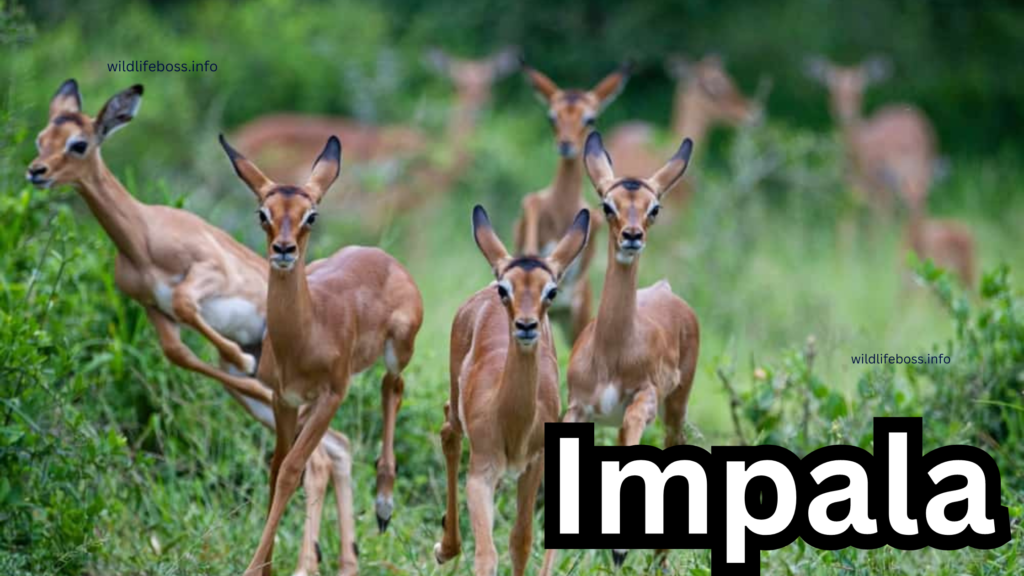
Scientific Name: Aepyceros melampus
Quick Summary: An antelope featuring lengthy, curving horns.
Originating in the savannas and grasslands of southern and eastern Africa, the impala is a medium-sized antelope. Similar to gazelles, impalas are swift animals.
Although they can’t maintain this speed for very long, they have been recorded moving at roughly 50 miles per hour.
Apart from their fast running, impalas are excellent jumpers. They have a ten-foot vertical leap. They have the ability to bound while running, covering around thirty feet in one bound.
Impalas are distinguished by their characteristic curving horns, as well as by their dark faces, white underbellies, and reddish-brown coats.
The horns, exclusive to male impalas, can reach a maximum length of 36 inches. In addition to being hornless, female impalas are also smaller than male impalas in relation to one another.
In contrast to gazelles, impalas require a diet rich in water. In actuality, they are usually located close to sources of water. The graze and browse, eating mainly plants, fruits, blossoms, leaves, and vegetable.
Male impalas fight each other during a rut in an effort to gain control over the females. Males will use their big horns to attack one another.
To intimidate other males, they also adopt aggressive stances, emit loud grunts and roars, and blow out the fur on their necks.
3. Oribi
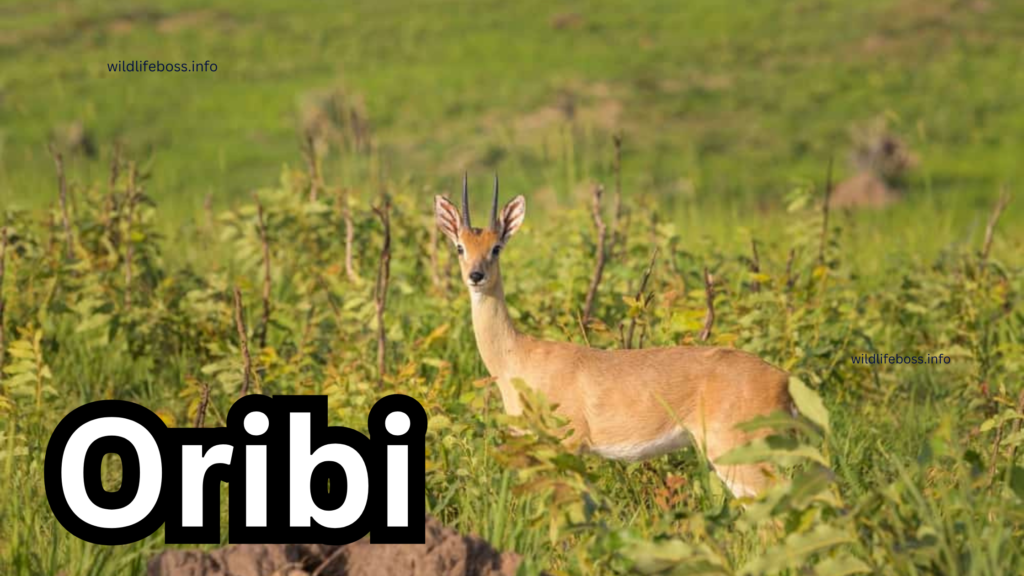
Scientific Name: Ourebi ourebi
Quick Summary: A tiny antelope with characteristics similar to the animals like gazelles
Only one species of tiny antelope is known as the oribi. This animal is known as the tiniest ruminant by many biologists. It resembles the gazelle more than any other species of antelope, possibly.
The oribi is a small, slender antelope that is native to sub-Saharan Africa. Its coat is reddish-brown. A characteristic tuft of black fur is present on the forehead of male oribis. Oribis weigh only approximately thirty pounds and are 20 to 30 inches tall.
The habitats of oribis include grasslands, savannas, and forested areas. Oribis, animals like gazelles, are water-independent and get their water from the food they eat.
Grazing and browsing on grasses, foliage, herbs, flowers, and fruits, oribis are herbivores.
The oribi is a swift and nimble animal that can leap over three feet and bound over six feet. With quick bursts of up to 50 miles per hour, they exploit their speed to get away from predators.
The oribis will run in a zigzag style to deceive their pursuers.
4. Springbok
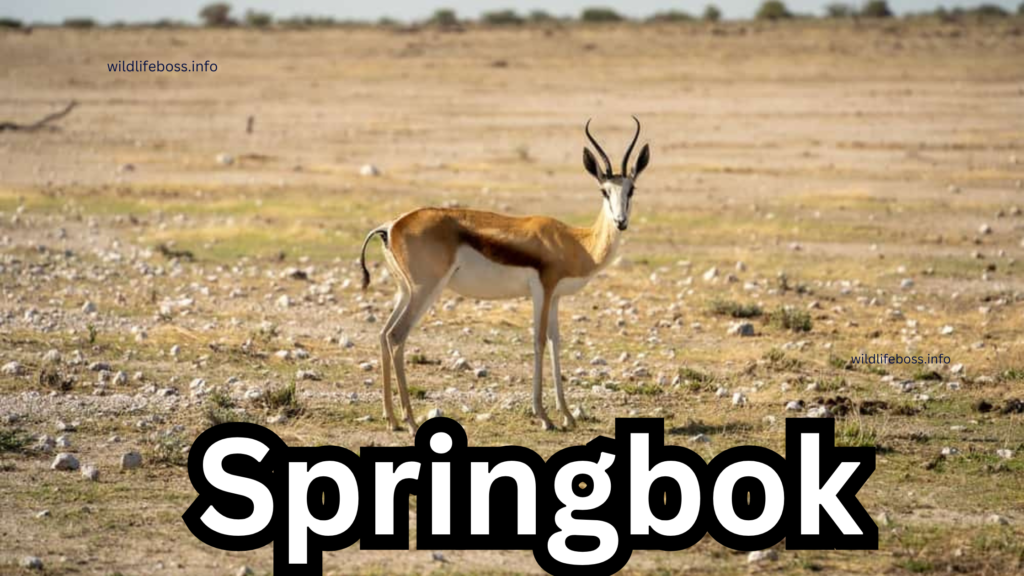
Scientific Name: Antidorcas marsupialis
Quick Summary: An antelope raising.
A medium-sized antelope species, the springbok is distinguished by its stunning golden coat, which features a white underbelly and a dark band running down the middle of its back.
Large ears and elegant, long legs characterize springboks. Springboks have horns that are black, curved at the end, and measure between 15 and 20 inches in length for both males and females.
The grasslands and savannahs of southern Africa are home to springboks. Similar to gazelles, springboks organize themselves into mixed harems, bachelor groups, and all-female groups.
Springboks have reached speeds of 55 mph. They also participate in “pronking,” which is the act of repeatedly leaping into the air while twisting and raising their legs high. They are able to jump over six and a half feet high.
The primary dangers to the springboks include African wild dogs, cheetahs, lions, leopards, jackals, and humans who hunt them for their flesh and fur.
Baby springboks are vulnerable to attack by large eagles, such as the tawny and Verreaux’s eagles.
Animals like gazelles and springboks are similar in that they may obtain all the water they require from their diet. They don’t need to drink any water to last through the whole dry season.
They are picky eaters, only consuming seeds, grasses, flowers, and succulent leaves.
In contrast to most other African animals, springboks congregate in groups during the wet season and lead more solitary lives during the dry season.
Sea also: 8 Best Animals Like Elk(with photos)
5. Dik-Dik

Scientific Name (genus): Madoqua
Quick Summary: A little antelope that speaks for itself.
The slender, long-legged dik-dik antelope, with a delicate appearance, is indigenous to the bushlands of southern and eastern Africa. One of the cutest antelopes is the dik-dik, with its delicate physique, narrow face, and defined eyes.
The sound that female dik-diks make when they raise a danger alert is how the dik-dik got its name. Dik-diks are typically 12 to 15 inches tall at the shoulder, with females being significantly larger than males.
Their lengthy legs are mostly responsible for their height. These legs help them flee from predators; dik-diks have been seen traveling at high to 26 mph.
The dik-dik has a peculiar feature: a long snout that looks like an anteater. The dik-dik cannot obtain food with the help of this modification.
Scientists surmise that by letting air chill the dik-dik’s blood before it circulates throughout its body, it helps fry the animal in the intense African heat.
The horns of male dik-diks are just three inches long and have grooves on them. The underbelly of both males and females is slightly lighter in color than their tannish brown coats.
The black and white fur rings that around each eye give the dik-dik’s eyes the appearance of being much bigger than they actually are.
There’s more surprise in the dik-dik’s eyes. The dik-dik are the animals like gazelles possesses a gland that secretes a sticky material at the inner corner of each eye.
The dik-dik marks its territory by putting twigs, leaves, or plant stems into its excretion.
6. Klipspringer

Scientific Name: Oreotragus oreotragus
Quick Summary: lying on stony mountains.
The last surviving member of its genus is the klipspringer, which is native to eastern and southern Africa.
The klipspringer is one of the antelope species that is least concerned about habitat loss since it prefers to reside in rocky areas that are unsuitable for farming or construction.
The klipspringer blends well with the rocks and crags because to its mottled coat of reddish, brown, and gray. Compared to the gazelle and other African antelopes, the klipspringer has fur that is far rougher and thicker.
Klipspringers feature short horn spikes that are only a few inches long, and they range in height from 17 to 23 inches.
The African antelope known as klipspringers is monogamous, in contrast to the animals like gazelles.
A male and female will unite to establish a bonded couple that will stick together for many years, if not forever. As a matter of fact, the couples are typically never more than 20 feet apart.
The mated pair, their offspring, and families are the traditional territories that the klipspringers create.
During the birthing season, which runs from spring to early summer, the female will give birth to one calf annually. For the first year of its life, the child stays with its mother.
7. Reedbuck
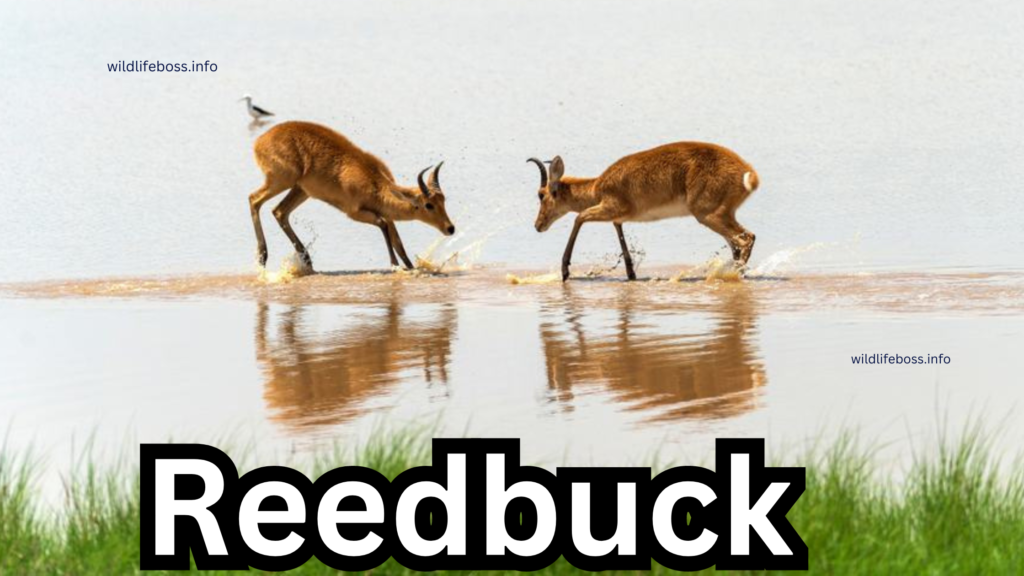
Scientific Name (genus): Redunca
Quick Summary: Build for quick starts.
Male reedbuck horns that curve forward are a distinguishing feature among the three kinds of this medium-sized African animal.
The southern reedbuck, mountain reedbuck, and bohor reedbuck—which inhabits the northern grasslands and savannas of sub-Saharan Africa—are the three varieties of reedbucks called after their respective habitats.
Male reedbucks are slightly larger than females, and their height can vary from 25 to 41 inches, depending on the species and region.
Colors of coats also differ. The mountain reedbuck’s fur is dark brown gray as while the fur of the southern and bohor reedbucks is lighter tan and more golden in color. Animals like gazelles, mountain reedbucks are able to go for extended periods of time without consuming water, relying instead on the green vegetation they eat to stay hydrated.
Being nocturnal grazers, reedbucks must be concealed from predators by dense vegetation or long grasses.
The reedbuck’s hind legs are considerably stronger and more muscular than its front legs, which enables it to leap higher and accelerate more quickly.
Although they are not designed for the animals like gazelles high speeds, they can leap large distances and run quickly to avoid a predator. The two animals that can attack reedbucks the most are African wild dogs and spotted hyenas.
Researchers see the transition between solitary antelope species and those with intricate social structures in reedbucks.
While they are not as gregarious as springboks as monogamous as klipspringers, reedbucks are also not entirely solitary creatures.
8. Eland
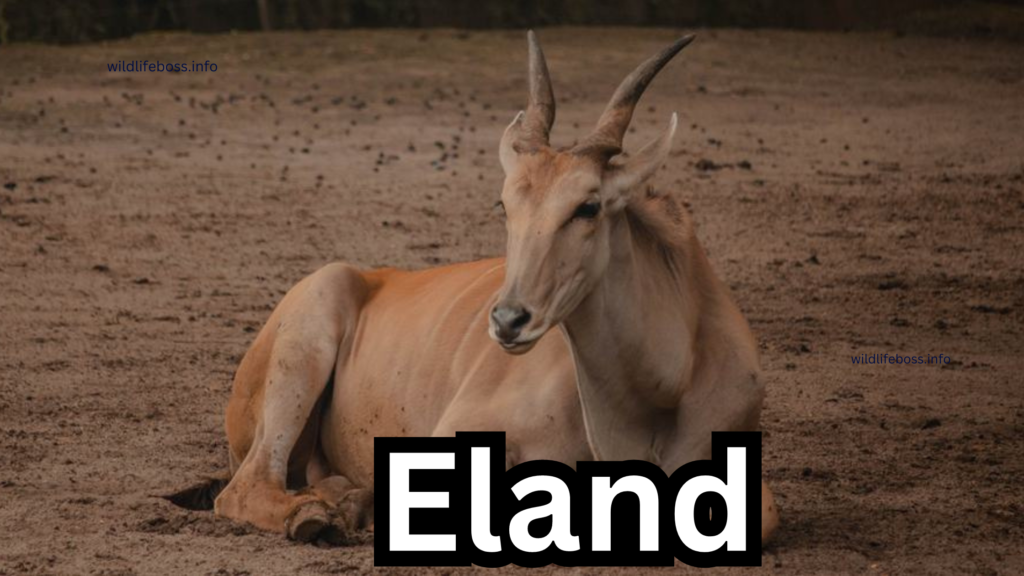
Scientific Name: Taurotragus oryx
Quick Summary: the biggest and slowest species of antelope.
A huge African animal, the eland differs from the dik-dik and oribi. The eland, the largest of all antelope species, can reach a shoulder height of five feet and a weight of up to 2,000 pounds.
Be not fooled by their bulk; elands are placid animals.
The most massive and slowest type of antelope is the eland. The eland can only reach a maximum speed of roughly 25 mph, and they are not able to maintain this speed for very long. Their maximum speed is a steady trot of roughly 14 mph.
Elands can jump, yet not being particularly quick runners. They may leap more than eight feet into the air from a standing start if they are alarmed.
Long, spiral horns are present on both sexes of elands. Elands with male characteristics have bigger and shorter horns than females. When it comes to fighting during the rutting season, male elands utilize their horns as weapons.
Conclusion:
The greatest number of antelope species are found in Africa.
Although antelopes are related to deer, goats, bison, and sheep, they are prey for larger carnivorous predators found in Africa, such as lions, hyenas, wild dogs, and cheetahs. However, antelopes have adapted to using speed as a means of escape.
In particular, the animals like gazelles is a quick sprinter that makes quick getaways.


Pingback: 8 Amazing Animals Like Elk(with Photos) - Wildlifeboss.info